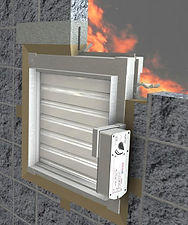Fire and Smoke Damper
Fire, smoke, and combination fire/smoke dampers are crucial pieces of equipment used to reduce the spread of fire and smoke throughout a building. As with all fire protection and life safety equipment, fire and smoke dampers must be properly inspected, tested, and maintained to ensure that they will operate when needed
FIRE SAFETY
(425 ILCS 13/) Fire and Smoke Damper Inspection Act.
Fire Damper Inspection & Smoke Damper Inspections
The National Fire Protection Association (NFPA) and the International Building and Fire Codes require regular maintenance of fire and smoke dampers. Authorities Having Jurisdiction (AHJ’s) such as the Joint Commission, fire marshals and insurance risk auditors enforce these requirements.
NFPA also requires that fire and smoke damper repairs begin without delay.

Fire Damper Commissioning
Per NFPA 3, interconnected life safety systems (both active and passive fire protection systems), will undergo testing after the initial commissioning process. This ensures the fire safety system remains operational and that it works as intended in the event of a fire.
What is Commissioning?
“The basic purpose of building commissioning is to provide a quality-based process with documented confirmation that building systems are planned, designed, installed, tested, operated, and maintained in compliance with the owner’s project requirements. Commissioning of existing systems may require the development of new functional criteria in order to address the owner’s current systems performance requirements”. – The Building Commissioning Association (BCA)
Fire Damper & Smoke Damper Repair/Installation
Proper maintenance of fire, smoke, and fire/smoke dampers is crucial to ensure that they remain operational. If a damper is found to not be operational, repairs need to be completed without delay and a periodic test must be completed after the repair is completed to ensure the damper’s operation. All exposed moving parts of the damper need to be lubricated as required by the manufacturer and any reports of an abrupt change in airflow or noise from a duct system needs to be investigated to ensure that it is not related to the damper operation.
Proper inspection, testing, and maintenance of fire, smoke, and fire/smoke dampers ensure they are installed and operating properly in the event of an emergency.

Before
(Failed)
After
(Repaired)








